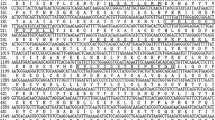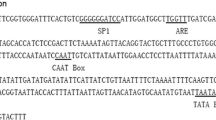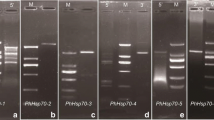Abstract
In this study, a full-length cytosolic heat shock protein 70 complementary DNA (cDNA) of Laminaria japonica (designated as LJHsp70) was obtained by reverse transcriptase-polymerase chain reaction (RT-PCR) coupled with rapid amplification of cDNA ends. The full length of LJHsp70 cDNA was 2,918 bp, with a 5′ untranslated region of 248 bp, a 3′ untranslated region of 696 bp, and an open reading frame of 1,974 bp encoding a polypeptide of 657 amino acids with an estimated molecular mass of 72.03 kDa and an estimated isoelectric point of 4.97. There was highly repeated sequence of CAA in 5′ untranslated region of LJHsp70. The result of phylogenetic tree of Hsp70s, the BLAST program, analysis and cytosolic Hsp70-specific motif of LJHsp70 verified that the cloned LJHsp70 belonged to cytosolic Hsp70 family. Three typical Hsp70 signature motifs were detected in LJHsp70 by InterPro analysis. Under different stress conditions, messenger RNA (mRNA) expression levels of LJHsp70 were quantified by quantitative RT-PCR. To L. japonica sporophytes kept in different temperatures for 1 h, the expression level of LJHsp70 at 30°C was highest and twofold higher than that at 10°C. To L. japonica sporophytes kept at 25°C for different times, the mRNA expression level of LJHsp70 reached a maximum level after 7 h and then dropped progressively. The expression level of LJHsp70 at 0 or 5‰ salt concentration for 2 h was twofold higher than that at 30‰ salt concentration for 2 h. The results showed that LJHsp70 may be a kind of potential biomarker used to monitor environment conditions.






Similar content being viewed by others

References
Ananthan J, Goldberg AL, Voellmy R (1986) Abnormal proteins serve as eukaryotic stress signals and trigger the activation of heat shock genes. Science 232:522–524
Barua D, Heckathorn SA (2006) The interactive effects of light and temperature on heat-shock protein accumulation in Solidago altissima (Asteraceae) in the field and laboratory. Am J Bot 93:102–109
Boorstein WR, Ziegelhoffer T, Craig EA (1994) Molecular evolution of the Hsp70 multigene family. J Mol Evol 38:1–17
Collén J, Guisle-Marsollier I, Leger JJ, Boyen C (2007) Response of the transcriptome of the intertidal red seaweed Chondrus crispus to controlled and natural stresses. New Phytol 176:45–55
Dahlhoff EP (2004) Biochemical indicators of stress and metabolism: applications for marine ecological studies. Annu Rev Physiol 66:183–207
Downs CA, Heckthorn SA, Bryan JK, Coleman JS (1998) The methionine-rich low-molecular-weight chloroplast heat shock protein: evolutionary conservation and accumulation in relation to thermotolerance. Am J Bot 85:175–183
Feder ME, Hofmann GE (1999) Heat-shock proteins, molecular chaperones, and the stress response: evolutionary and ecological physiology. Annu Rev Physiol 61:243–282
Fink AL (1999) Chaperone-mediated protein folding. Physiol Rev 79:425–449
Geraci F, Pinsino A, Turturici G, Savona R, Giudice G, Sconzo G (2004) Nickel, lead, and cadmium induce differential cellular responses in sea urchin embryos by activating the synthesis of different Hsp70s. Biochem Biophys Res Commun 322:873–877
Gething MJ, Sambrook J (1992) Protein folding in the cell. Nature 355:33–45
Gimmler H (2000) Primary sodium plasma membrane ATPases in salt-tolerant algae: facts and fictions. J Exp Bot 51:1171–1178
Goodman R, Blank M (1998) Magnetic field stress induces expression of hsp70. Cell Stress Chaperon 3:79–88
Gupta R, Golding G (1993) Evolution of HSP70 gene and its implications regarding relationships between archaebacteria, eubacteria, and eukaryotes. J Mol Evol 37:573–582
Guy CL, Li QB (1998) The organization and evolution of the spinach stress 70 molecular chaperone gene family. Plant Cell 10:539–556
Halpin PM, Sorte CJ, Hofmann GE, Menge BA (2002) Patterns of variation in levels of Hsp70 in natural rocky shore populations from microscales to mesoscales. Integr Comp Biol 42:815–824
Hamdoun AM, Cheney DP, Cherr GN (2003) Phenotypic plasticity of HSP70 and HSP70 gene expression in the pacific oyster (Crassostrea gigas): Implications for thermal limits and induction of thermal tolerance. Biol Bull 205:160–169
Hartl FU (1996) Molecular chaperones in cellular protein folding. Nature 381:571–579
Hartl FU, Hayer-Hartl M (2002) Molecular chaperones in the cytosol: from nascent chain to folded protein. Science 295:1852–1858
Henkel SK, Hofmann GE (2008a) Differing patterns of hsp70 gene expression in invasive and native kelp species: evidence for acclimation-induced variation. J Appl Phycol 20:915–924
Henkel SK, Hofmann GE (2008b) Thermal ecophysiology of gametophytes cultured from invasive Undaria pinnatifida (Harvey) Suringar in coastal California harbors. J Exp Mar Biol Ecol 367:164–173
Hofmann GE, Somero GN (1995) Evidence for protein damage at environmental temperatures—seasonal changes in levels of ubiquitin conjugates and Hsp70 in the intertidal mussel Mytilus trossulus. J Exp Biol 198:1509–1518
Hong SW, Vierling E (2000) Mutants of Arabidopsis thaliana defective in the acquisition of tolerance to high temperature stress. Proc Natl Acad Sci U S A 97:4392–4397
Howarth CJ (1991) Molecular responses of plants to an increased incidence of heat-shock. Plant Cell Environ 14:831–841
Ireland HE, Harding SJ, Bonwick GA, Jones M, Smith CJ, Williams JH (2004) Evaluation of heat shock protein 70 as a biomarker of environmental stress in Fucus serratus and Lemna minor. Biomarkers 9:139–155
Iwamoto K, Shiraiwa Y (2005) Salt-regulated mannitol metabolism in algae. Mar Biol 7:407–415
Jolly C, Morimoto RI (1999) Stress and the cell nucleus: dynamics of gene expression and structural reorganization. Gene Expr 7:261–270
Joubert Y, Fleurence J (2005) DNA isolation protocol for seaweeds. Plant Mol Biol Rep 23:197a–197g
Karlin S, Brocchieri L (1998) Heat shock protein 70 family: multiple sequence comparisons, function, and evolution. J Mol Evol 47:565–577
Lewis S, May S, Donkin ME, Depledge MH (1998) The influence of copper and heat shock on the physiology and cellular stress response of Enteromorpha intestinalis. Mar Environ Res 46:421–424
Lewis S, Donkin ME, Depledge MH (2001) Hsp70 expression in Enteromorpha intestinalis (Chlorophyta) exposed to environmental stressors. Aquat Toxicol 51:277–291
Li QB, Guy CL (2001) Evidence for non-circadian light/dark regulated expression of hsp70s in spinach leaves. Plant Physiol 125:1633–1642
Li R, Brawley SH (2004) Improved survival under heat stress in intertidal embryos (Fucus spp.) simultaneously exposed to hypersalinity and the effect of parental thermal history. Mar Biol 144:205–213
Mager WH, de Boer AH, Siderius MH, Voss HP (2000) Cellular responses to oxidative and osmotic stress. Cell Stress Chaperon 5:73–75
Manitašević S, Dunderski J, Matic G, Tucic B (2007) Seasonal variation in heat shock proteins Hsp70 and Hsp90 expression in an exposed and a shaded habitat of Iris pumila. Plant Cell Environ 30:1–11
Mayer MP, Bukau B (2005) Hsp70 chaperones: cellular functions and molecular mechanism. Cell Mol Life Sci 62:670–684
Morimoto RI, Kline MP, Bimston DN, Cotto JJ (1997) The heat-shock response: regulation and function of heat-shock proteins and molecular chaperones. Essays Biochem 32:17–29
Mycko MP, Cwiklinska H, Walczak A, Libert C, Raine CS, Selmaj KW (2008) A heat shock protein gene (Hsp70.1) is critically involved in the generation of the immune response to myelin antigen. Eur J Immunol 38:1999–2013
Nelson RJ, Ziegelhoffer T, Nicolet C, Werner-Washburne M, Craig EA (1992) The translation machinery and 70 kD heat shock protein cooperate in protein synthesis. Cell 71:97–105
Ohtsuka K, Hata M (2000) Molecular chaperone function of mammalian Hsp70 and Hsp40-a review. Int J Hyperther 16:231–245
Piano A, Asirelli C, Caselli F, Fabbri E (2002) Hsp70 expression in thermally stressed Ostrea edulis, a commercially important oyster in Europe. Cell Stress Chaperon 7:250–257
Piano A, Valbonesi P, Fabbri E (2004) Expression of cytoprotective proteins, Hsp70, and metallothioneins in tissues of Ostrea edulis exposed to heat and heavy metals. Cell Stress Chaperon 9:134–142
Renner T, Waters ER (2007) Comparative genomic analysis of the Hsp70s from five diverse photosynthetic eukaryotes. Cell Stress Chaperon 12:172–185
Rizhsky L, Liang H, Mittler R (2002) The combined effect of drought stress and heat shock on gene expression in tobacco. Plant Physiol 130:1143–1151
Roeder V, Collén J, Rousvoal S, Corre E, Leblanc C, Boyen C (2005) Identification of stress genes from Laminaria digitata (Phaeophyceae) protoplast cultures by expressed sequence tag analysis. J Phycol 41:1227–1235
Sagarin RD, Somero GN (2006) Complex patterns of expression of heat-shock protein 70 across the southern biogeographical ranges of the intertidal mussel Mytilus californianus and snail Nucella ostrina. J Biogeogr 33:622–630
Sharma AD, Gill PK, Singh P (2002) DNA isolation from dry and fresh samples of polysaccharide-rich plants. Plant Mol Biol Rep 20:415a–415f
Smith TR, Tremblay GC, Bradley TM (1999) Hsp70 and a 54 kDa protein (Osp54) are induced in salmon (Salmo salar) in response to hyperosmotic stress. J Exp Zool 284:286–298
Snyder MJ, Girvetz E, Mulder EP (2001) Induction of marine mollusc stress proteins by chemical or physical stress. Arch Environ Contam Toxicol 41:22–29
Sørensen JG, Loeschcke V (2001) Larval crowding in Drosophila melanogaster induces hsp70 expression, and leads to increased adult longevity and adult thermal stress resistance. J Insect Physiol 47:1301–1307
Sung DY, Kaplan F, Guy CL (2001) Plant Hsp70 molecular chaperones: protein structure, gene family, expression and function. Physiol Plant 113:443–451
Suzuki S, Furuya K, Takeuchi I (2006) Growth and annual production of the brown alga Laminaria japonica (Phaeophyta, Laminariales) introduced into the Uwa Sea in southern Japan. J Exp Mar Biol Ecol 339:15–29
Tanaka KI, Namba T, Arai Y, Fujimoto M, Adachi H, Sobue G, Takeuchi K, Nakai A, Mizushima T (2007) Genetic evidence for a protective role for heat shock factor 1 and heat shock protein 70 against colitis. J Biol Chem 282:23240–23252
Tomanek L, Sanford E (2003) Heat-shock protein 70 (HSP70) as a biochemical stress indicator: an experimental field test in two congenic intertidal gastropods (genus: Tegula). Biol Bull 205:276–284
Vayda ME, Yuan ML (1994) The heat shock response of an Antarctic alga is evident at 5°C. Plant Mol Biol 24:229–233
Verbeke P, Fonager J, Clark BC, Rattan SIS (2001) Heat shock response and ageing: mechanisms and applications. Cell Biol Intern 25:845–857
Wagner M, Hermanns I, Bittinger F, Kirkpatrick CJ (1999) Induction of stress proteins in human endothelial cells by heavy metal ions and heat shock. Am J Physiol 277:L1026–L1033
Wickner S, Mauriz MR, Gottesman S (1999) Posttranslational quality control: folding, refolding and degrading proteins. Science 286:1888–1893
Yao JT, Fu WD, Wang XL, Duan DL (2009) Improved RNA isolation from Laminaria japonica Aresch (Laminariaceae, Phaeophyta). J Appl Phycol. doi:10.1007/s10811-008-9354-0
Acknowledgments
This work was supported by the Shandong Agriculture Seedstock Breeding Project, knowledge Innovation Program of the Chinese Academy of Sciences (KSCX2-YW-N-47-02), and the CAS/SAFEA International Partnership Program for Creative Research Teams (Research and Applications of Marine Functional Genomics) for financial assistance. The author thanks anonymous reviewers for the critical comments and suggestions for the manuscript.
Author information
Authors and Affiliations
Corresponding author
Rights and permissions
About this article
Cite this article
Fu, W., Yao, J., Wang, X. et al. Molecular Cloning and Expression Analysis of a Cytosolic Hsp70 gene from Laminaria japonica (Laminariaceae, Phaeophyta). Mar Biotechnol 11, 738–747 (2009). https://doi.org/10.1007/s10126-009-9188-z
Received:
Accepted:
Published:
Issue Date:
DOI: https://doi.org/10.1007/s10126-009-9188-z



